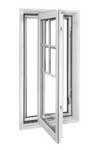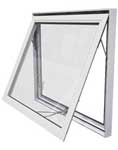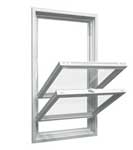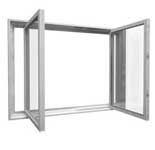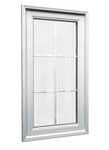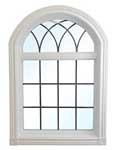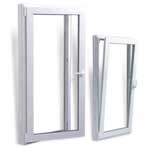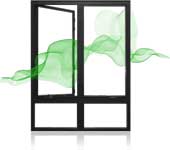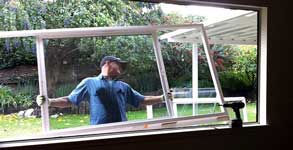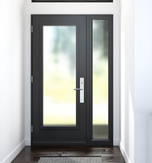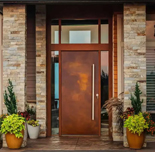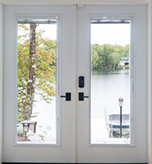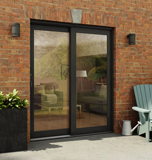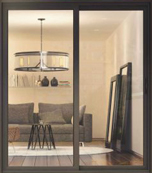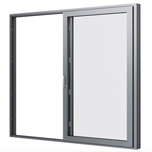Windows are an important component of a home. In addition to enhancing the esthetic beauty of the house, windows can provide fresh air and ventilation to the home, allow daylighting to brighten interior spaces and keep out harsh outdoor elements (wind, rain, snow).
Buying new windows can be a daunting task, especially for the uninitiated. Knowing the type of window best suited for your home and geographic location can help you choose a window that reduces direct drafts from air leakage and the potential for damage from water leaks. It’s important to understand how windows perform with respect to these factors. Equally important, knowing what to look for in a window can help you avoid buying something you don’t need.
The performance of windows sold in Canada is defined in a Canadian Standards Association standard called CSA A440 (Windows). This standard sets the type of materials that are to be used in the manufacture of windows and some minimum material properties, such as thickness, hardness and durability. The A440 Standard also defines minimum performance levels for windows evaluated under a standardized set of conditions.
The characteristics defined in the A440 Standard include:
- Airtightness*
- Watertightness*
- Wind load resistance*
- Ease of operation
- Resistance to forced entry
- Condensation resistance
- Screen strength
All windows sold in Canada must be evaluated for their performance level in airtightness, watertightness and wind load resistance — the characteristics marked with an asterisk (*) in the list above. This About Your House focuses primarily on these characteristics. Evaluating windows for the other characteristics is voluntary, so not all windows are evaluated for their ability to resist, for example, forced entry.
Why is an Air Leakage Standard so Important?
The uncontrolled movement of air into or out of the house is a cost to the homeowner. For example, any cold outdoor air that leaks into the home (air infiltration) must be heated to room temperature to maintain the comfort of the occupants, so air infiltration is a heating cost. The same problem occurs in air-conditioned homes during the summer, when warm outdoor air infiltrates, resulting in an additional cooling load.
When interior-conditioned air (either heated for winter or cooled for summer) leaks to the outside, the homeowner also pays the energy costs associated with the air leakage.
Windows are tested for air leakage by applying a standardized air pressure (roughly equivalent to a 40 km/h — 25 mph — wind) across a window of a standard size. The amount of air that leaks through the window at that pressure difference is measured.
Depending on the test result, windows are given one of the following airtightness performance ratings:
- A1 (somewhat leaky),
- A2 (slightly leaky), or
- A3 (not very leaky).
In general, fixed windows tend to have higher airtightness performance ratings because they allow less air to pass through the unit than windows that open and shut. Slider windows tend to be leakier than casement windows. All windows sold in Canada must at least meet the A1 performance level to comply with local building codes.
A higher A rating is a desirable attribute for a window if your home is located in a region known to have frequent high winds or gusty winds.
The rated performance only indicates the window’s leakiness relative to other products evaluated. Installation procedures, manufacturing tolerances and other factors also contribute to performance of an installed window. Window units are not evaluated when installed in a wall, so a window rated at a specific performance level may not perform at that level when installed.
Window rating programs are intended to allow consumers to compare similar products, not to predict, for example, air leakage rates. The thinking is that, if one window has a better airtightness rating than another, it will have less air leakage when installed.
Windows may also allow water to leak into the house during rainstorms, leading to water damage of interior finishes and potential mold growth. Because of this, all windows sold in Canada are evaluated for their ability to resist water leakage and for resistance to wind-driven rain. Water is continuously sprayed onto the outside of a standard-sized window under standard temperature and air pressure conditions.
The window is rated in accordance with the highest air-pressure level for which no water leakage occurs.
A B1 rating is assigned to a window that exhibits no water leakage at a relatively low air-pressure difference across the window. It is the lowest permissible result.
All windows sold in Canada must meet at least the B1 rating to comply with local building codes.
Every rating number above B1 represents the highest air-pressure condition for which no water leakage occurs. For example, a window rated B4 that shows no water leakage at a test pressure of 400 pascals (Pa) — the metric unit of pressure — presumably leaks at higher pressures.
The highest possible rating in the A440 Standard for resistance to wind-driven rain is B7, equivalent to a window resisting water leakage at wind speeds greater than 120 km/h (75 mph.) — a high-performance product.
As noted for air leakage, the B rating does not necessarily indicate the performance of the product as installed. It should only be used to compare products. The B rating is a very important performance index in coastal climates, where wind-driven rain is relatively common. A window rated B2 would be the minimum advisable for low-rise houses (typically four stories or less) in most of Canada, except for the areas mentioned in Table 1.
Table 1 — Suggested Minimum Ratings for Wind-driven Rain Resistance
| For most of Canada | B2 |
| Haida Gwaii/Queen Charlotte Islands | B5 |
| Western Vancouver Island | B4 |
| Eastern Vancouver Island and north coast of B.C. | B3 |
| Southeastern Alberta, southern Saskatchewan | B3 |
| St. Lawrence Valley, east Baffin Island, east New Brunswick, Nova Scotia, central Newfoundland | B3 |
| Gaspé, Prince Edward Island, Gulf of St. Lawrence, coastal Labrador, coastal Newfoundland | B4 |
The above B ratings are appropriate for low-rise residences in relatively sheltered areas, and are only a suggested minimum. Building height, shape and location, such as on hilltops, promontories or bluffs, can increase the effect of wind-driven rain, so that higher B ratings are advised. In new construction or replacement of existing windows, it is advisable to discuss and choose the window rating levels with a design professional.
Windows are also tested for their ability to resist wind pressures without deforming too much and without blowing out of their frames. Test windows are subjected to a large air-pressure difference to simulate hurricane-force winds (120 km/h and higher). The resulting deformation of the framing components is measured, with the window receiving a rating ranging from C1 — deflection or blowout of the window at gale-force winds (62 – 74 km/h — 39 – 46 mph.) — toC5 — resistance to extremely high wind pressures without blowout or permanent deformation. Windows rated C5 are appropriate for some high-rise buildings, or for low-rise buildings in very windy climates.
A window rated C2 is the minimum advisable for low-rise houses in most of Canada, except for the areas in the Table 2.
Table 2 — Suggested Minimum Ratings for Wind Resistance
| For most of Canada | C2 |
| Haida Gwaii/Queen Charlotte Islands, western Vancouver Island | C3 |
| Alberta south of High River, except Cardston area (see below) | C3 |
| Cardston area of Alberta | C4 |
| Lower St. Lawrence Valley (Baie-Comeau, Sept-Îles, Matane), western Prince Edward Island, western Cape Breton Island, east Baffin Island, Labrador, Newfoundland (see exceptions below) | C3 |
| Cape Race, Gaspé region, Gulf of St. Lawrence, Resolution Island, Coral Harbour | C4 |
The above C ratings are suggested for low-rise houses in relatively sheltered areas. They are typical values for the regions listed. Building height, shape and location, such as on hilltops, promontories or bluffs, increase the effect of wind pressures, so higher C ratings are advised. Higher ratings are also suggested if local wind conditions are higher than the average values for the regions listed. Typical wind-pressure levels for the regions listed (upon which the suggested C ratings are based) are taken from meteorological data valid for the location of the meteorological station. There may be, for example, regions in the Gaspé or in southern Alberta for which C5 ratings would be advisable.
Manufacturers may, but are not required to, have their windows tested for ease of operation, resistance to forced entry, condensation and screen strength.
Ease of Operation
Many operable windows are tested to ensure that their operation is relatively smooth, with no jamming of operator mechanisms. The amount of force required to turn operator cranks or slide windows open and closed is measured in the test and cannot exceed set levels.
As is always the case with standardized testing, however, the performance of the product sold may vary slightly from the rated value. The CSA Standard only indicates whether a window model meets or does not meet the requirements of this (voluntary) portion of the test. Consumers are encouraged to test window operation for themselves, noting that showroom models may have been opened and closed many times, and that dealers are unlikely to display products that do not operate properly.
Over time, gaskets and seals will tend to wear, so that window operation will become easier, but the window will also tend to leak more air and water.
Resistance to Forced Entry
The CSA Window Standard includes a test method to determine a window’s resistance to forced entry, but consumers are advised not to rely entirely on this rating for security of their person and property. A consumer-rating index is no substitute for normal precautions against unwanted or unlawful entry.
Condensation Resistance
The CSA procedure contains standardized test methods to evaluate a window’s tendency to allow condensation to form on the glazing or framing members under winter conditions. Condensation, due to air leakage or heat loss through the unit itself, can damage adjacent building materials or cause fungal growth.
The warning that rated performance is different from actual performance of products sold is never more important than with this index. A wide range of variables can influence the formation of condensation, including:
- air leakage, through the window and around its perimeter;
- relative humidity of the interior air (the higher the humidity the greater the potential for condensation);
- where the window is installed in the wall (windows installed farther to the outside of the wall tend to exhibit more condensation);
- curtains, drapes, or blinds, which tend to restrict air movement on the window and thus promote condensation;
- the presence (or absence) of convection heaters below the window;
- placing objects (plants, photographs, books, and so on) on the windowsill tends to restrict air movement on the window and thus promotes condensation.
Condensation resistance of windows has an index called the Temperature Factor (TF). The TF can be thought of as an indication of whether the interior surface temperatures are more like the interior or the exterior. If the interior surface temperatures of the window were the same as the outdoor temperature, the TF would be 0; if the interior surfaces of the window were as warm as the room air, the TF would be 100.
If a window is tested for condensation resistance, the minimum level required to meet the A440 performance standard is TF 40. This is approximately equivalent to a double-glazed window with a thermally broken metal frame. Higher ratings are suggested for humid climates, for example, near lakeshores, oceans or in river valleys.
Higher ratings may also be necessary in homes where interior relative humidity levels are higher than average — for example, where frequent showers are taken, or an unusually large number of plants are maintained, or food preparation involves large quantities of boiling water. However, in situations where high indoor humidity levels are expected, it may be more appropriate to address that issue directly (for example, by installing a dehumidifier or exhaust fan) rather than buying condensation-resistant windows.
Screen Strength
Operable windows usually feature a screen over the open portion of the window to keep insects outside. Depending on the force that can be applied without separating the screen from the frame, the screen is rated as either “Standard” or “Heavy Duty.” It is important to note that the screen strength test is only designed to determine the ability of the screen to resist nominal loads. An insect screen is neither a fall-prevention device nor an anti-theft feature: it is only intended to keep insects out.
Windows must be carefully selected to meet your needs. They must be suitable for resisting certain environmental exposures (such as rain and wind) and be within your budget. It takes care for the average homeowner and many professionals to make the best selection.
All windows sold in Canada must be evaluated for three key performance criteria, commonly referred to as the A-B-C window ratings.
A — airtightness (levels A1 to A3)
B — water resistance (levels B1 to B7)
C — wind resistance (levels C1 to C5)
Generally speaking, the higher the numbers, the better the window performance. Choose a rating level that satisfies the environmental conditions of your home. Determine if any of the voluntary performance criteria are required for your window(s) and if they meet the required standards.

